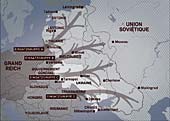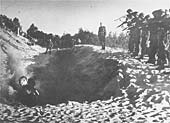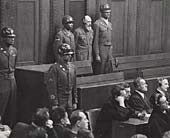The Holocaust by bullets, shooting in Ukraine - Shoah Memorial
- Presentation of the exhibition
- The Jews in Ukraine
- The beginning of the genocidal policy
- The radicalization of genocide
- Father Patrick Desbois and Yahad-In Unum
- The stages of execution
- Panoramic views of the exhibition
The radicalization of genocide
Parallel to the massacres they perpetrated in the occupied territories, the
The radicalization of the massacre of Jews is clearly visible with the numerous examples of killings, as in the region of Zhitomir, where 3,000 Jews were murdered in July 1941, about 10,000 in August and 27,000 in September. In the newly conquered regions, massacres were immediately of great magnitude. In urban areas, they often exceeded 10,000 victims like the sad example of Babi Yar (33,000).
In Crimea (attributed to Ukraine by Khrushchev after the Second World War but autonomous Soviet republic at the time of the German invasion) lived about 65,000 Jews. When the Germans conquered the region, at the beginning of November 1941, about 35,000 Jews had taken refuge further to the east. About 8,000 Jews had been mobilized in the Red Army. The Germans thus found about 23,000 Jews who were quickly the victims of a genocidal machine now running at full speed on Soviet territory. The killer units roamed the campaigns to not let any designated victims escape. Between mid-December and mid-January, gas vans were also tested.
The staff of the killing commandos were quickly tested, psychologically, by the repeated and increasingly systematic massacres they had to commit. When, at the end of 1941, it was decided to kill the Jews of all occupied Europe, gas chambers were set up in the extermination centres in Poland. But in Ukraine, as in the rest of the Soviet Union, the Nazi Reich did not have the possibility, due to the proximity of the front, to install extermination centers. Most often, the railway network was unsuitable for deportation to extermination centers located in Poland. That is why the "Holocaust by bullets" continued in Ukraine until the end of the occupation of the country by the Wehrmacht, at the beginning of 1944. Only about 20% of Ukrainian Jews were deported to Belzec, Sobibor and Auschwitz. The remaining 80% of the victims were killed by SS commandos or their auxiliaries.
Practically all those who did not flee were killed in the space of two and a half years, between June 1941 and December 1943.
According to the Ukrainian historian Alexander Kruglov, one might think that about a third of Ukrainian Jews escaped genocide, which means that, conversely, about one million five hundred thousand Jews died: 500,000 in 1941, more than 700,000 in 1942 and 200,000 from 1943 until the final abandonment of Ukraine by the Wehrmacht in 1944.
The first denial, that of the Nazis
The example of subcarpathic Ukraine shows that the Nazis murdered or had Jews assassinated as long as they could hold a part of the country. However, from the defeat at Stalingrad, retreat had been envisaged and, with it, the need to erase the traces of the crime. The Nazis were the first Holocaust deniers. The SS charged commandos, commanded by Paul Blobel (former head of Einsatzkommando 4a) and grouped under the name of camouflage
'operation 1005', to find the places of the massacres and to remove the bodies of the victims. But the places of massacres were too numerous to be all found before the Red Army arrived. The killings had not only been carried out by the
In terms of archives, the Nazis could not either make all traces disappear. Too many copies of the

The areas of action of the Einsatzgruppen in the Soviet Union.
Source: Institut für Zeitgeschichte, München -Berlin, 1999

Members of the Einsatzgruppen shooting at a group of men standing in a pit. Circa 1941-1942. Location unknown. Photographer unknown.
© USHMM, courtesy of Supplemental of the Austrian Centrifuge Plates

Paul Blobel (1894-1951). Nuremberg, Germany, 1948.
© Coll. CDJC/ Shoah Memorial